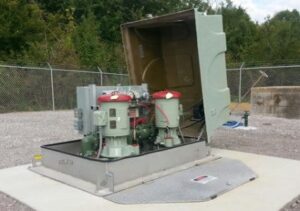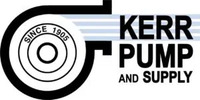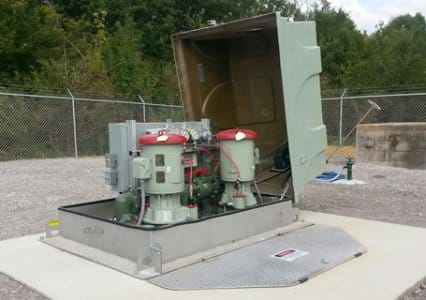“We knew our biggest problem was (our) lift stations, we just didn’t know exactly what to do about it.”
Standardized Lift Station Plan Embraces Packaged Concept for Operational and Cost-Saving Benefits
This case study is provided by Smith & Loveless.
The words of Jon Brown, former sewer system supervisor for Idaho’s Fremont County Public Works Department no doubt resonates with many of his peers around the country who are managing sewer and water treatment infrastructure. Lift stations (or pump stations) operate as critical components within a collection system as they keep the water flowing. When they are doing their job day and night, it becomes easy to overlook them. When they aren’t doing their job, they become impossible to ignore—just like a migraine headache.
For the Fremont County staff, a litany of issues gradually emerged over time as their collection system expanded, including the number of lift stations. The county operates a wastewater collection system in the Island Park region of rural Idaho, near Yellowstone National
Park. The area is made up of a vast expanse of accessible forest comprised of private and public lands making it an ideal place for residents and visitors to enjoy the outdoors. Because the region is a popular vacation destination for outdoor enthusiasts, many of the county’s lift stations operate in forested locales and other remote areas only accessible by off-road type vehicles.
A network of 47 lift stations conveys more than 175,000 gallons per day to two treatment plants. Despite being spread over an actual area of more than 24 square miles, only five public works technicians cover the entirety of the wastewater system including the treatment plants. Therefore, conducting preventative operation and maintenance or emergency repairs for lift stations became both time-consuming and difficult.
“Island Park is so spread out, it makes it tough,” Brown said. “There’s all these little cabins and properties [feeding the waste water collection] spread across the forest.”
Increasing recreational activity also led to frequent pump clogging events—consistent with the pandemic flushable issues occurring nationwide—and ultimately required the technicians to patrol on busy weekends and holidays instead of enjoying time with their families. Further complicating matters, the county had been operating and maintaining lift stations with 16 different manufacturer pump brands with many different models, configurations and ages, requiring a large and unwieldy spare parts inventory. This made it difficult to apply common troubleshooting practices, anticipate problems or conduct repairs without the use of outside contractors.
Developing Tiers & Templates
 With all of this in mind, the county contacted consulting engineering firm Keller Associates to seek solutions to improve operational efficiency. Keller Associates proposed a tiered standardization program that would reduce the number of lift station types and manufacturer brands operated by the county to three standard types based on size and capacity: (1) shallow, household type pumping systems with less than 5-horse-power motors; (2) mid-range lift stations with 5- to 50-hp motors; and (3) large regional and/or influent lift stations with 50-hp motors or larger and typically deeper wet wells.
With all of this in mind, the county contacted consulting engineering firm Keller Associates to seek solutions to improve operational efficiency. Keller Associates proposed a tiered standardization program that would reduce the number of lift station types and manufacturer brands operated by the county to three standard types based on size and capacity: (1) shallow, household type pumping systems with less than 5-horse-power motors; (2) mid-range lift stations with 5- to 50-hp motors; and (3) large regional and/or influent lift stations with 50-hp motors or larger and typically deeper wet wells.
Fremont County selected preferred manufacturers based on extensive experience with a variety of systems: a grinder pump manufacturer was selected for the small household pumping systems, a packaged above-ground pump stations manufacturer for the mid-range lift stations and a submersible manufacturer for the large lift stations.
“We’ve had so many different types of pump stations in the ground that we’ve figured out some of our likes and dislikes,” Brown said. “First and foremost, I want serviceability out of my pumps.”
By “serviceability,” Brown emphasized the need to access and perform maintenance on the pumping equipment more safely and easily. The county standardized on packaged above-ground lift stations for the mid-range station applications, which makes up most of the lift stations within the collection system from manufacturer Smith & Loveless, Inc. These packaged stations arrive pre-assembled with all pumps, valves and controls aligned on a common base with a quick-access enclosure, allowing quick and easy installation on the wet well after basic suction pipe and electrical connections were completed.
Immediate and safe ground-level access to the controls, valves and pumps means these systems significantly reduce the time and personnel required to perform regular O&M. Confined space entry and associated requirements are virtually eliminated, including permitting, harnesses, gas monitoring equipment, and other OSHA and Class 1 Division 1 requirements. Routine tasks like pulling a pump to change a seal or impeller can be completed in minutes by a single operator.
“Out of all the pumps I’ve worked with, I have to say [Smith & Loveless] hits the high mark on serviceability,” Brown said. “I love the above-ground lift station.”
The county’s previous mid-range lift stations clogged frequently during peak season, but after standardizing to the above-ground lift station these events have been significantly reduced.
“One submersible lift station in particular we used to call ‘the cash cow’ because my guys were constantly out there pulling pumps once or twice a week,” Brown said. “Since replacing it with the above-ground pump station with X-PELLER® Impeller, we have not had one pump clog in four years.”
Standardization in Action
Here’s how the standardization program works in practice:
1) The streamlined process begins with the county’s professional engineering consultant, which undertakes the lift station’s design and sizing.
2) Plans and specifications are then developed for the station with the county public works staff. They collectively review the necessary site-specific design details such as freeze protection and specialized impellers that prevent potential clogging events.
3) The design template is applied to the specific location, and the developed plans and specifications are submitted to the Idaho Department of Environmental Quality (IDEQ) for review and approval to construct. After IDEQ approval, a bid package is released for station pricing by the standardized lift station vendor, and the quotation and submittal process begin.
4) Following the submittal phase, the packaged lift station is completely manufactured and shipped to the county.
5) Once notified that the lift station is in transit, the county schedules their workforce to begin the demolition and replacement of any structural components that need to be replaced, i.e. wet wells, valve vaults, piping sections, etc.
Because of significant snow fall during the winter and subsequent high ground water from snow melt in the spring and early summer, the county has found it easiest to construct the stations in the late summer and fall. By following this plan, the county can install new equipment without impacting the region during peak tourist season.
In the case of the above-ground mid-range stations, installations are conducted with only existing public works staff, a convenience only made possible by the improved technical knowledge of the standard packaged design.
“We [public works technicians] do all the work for the wet well, the piping, so that we can easily install the lift station when it arrives,” Brown said. “All we have to do is run the pressure line, run the electrical, and install the base and we’re off running.”
The county prefers this construction approach because of the knowledge it gives their operations staff for the future operation of the lift station. Operators develop a deeper understanding of how the station is assembled and how it operates through this installation method.
Traditionally, a contractor would receive the hands-on training that comes with the commissioning and troubleshooting of a new piece of quipment. Fremont County has realized that this hands-on knowledge is invaluable and prefers that their staff receive the manufacturer’s training. While this approach initially required additional county staff resources to handle installation, the costs are more than absorbed in other ways: reduced out-of-pocket expense for contractors and long-term gain in operation and maintenance costs because of the operators’ increased ability to troubleshoot and anticipate problems before they become emergencies.
Overall, the tiered approach provides Fremont County with many time and cost-saving benefits. Size and complexity of spare parts inventory has been significantly reduced. Ongoing consulting engineering and contracting fees are virtually eliminated.
“We’ve saved the county mega money with this program,” Brown concluded.

